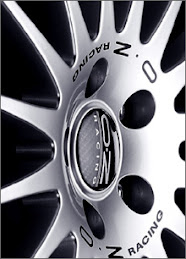
Mitsubishi Prototype for Next-generation Lancer Evolution
Mitsubishi Motors North America (MMNA) announced the world debut of the Prototype X, a concept vision of the next-generation Lancer Evolution that will become available in the first quarter of 2008.
While remaining true to the core values that have made the Lancer Evolution series synonymous with thrilling performance, the next-generation will offer all-around capability and user technology that distinguish the world's best performance models. The high-performance engine, sports car dynamics and striking design will appeal to enthusiasts worldwide - for those who desire a daily driver with street credentials as well as those anticipating weekend club racing.
Under its dramatic skin, Prototype X showcases an all-new 2.0-liter turbocharged engine and a new high performance all-wheel-drive system called Super-All Wheel Control (S-AWC). Prototype X also previews a new paddle-shift automated manual transmission that will be offered in the Lancer Evolution for the first time.
Coming Soon: Evolution Revolution
The Lancer Evolution has long lived up to its namesake by greatly improving with each successive generation. (Lancer Evolution VIII was the first to be offered in the U.S. market.) As Prototype X demonstrates, the Lancer Evolution will soon make perhaps the largest leap in overall capability seen between two generations of this model. The next Evolution will offer major gains in handling dynamics and technology while maintaining the kind of thrilling turbo engine performance that has made the model a street legend around the world.
Although clearly based on the new Lancer and sharing its distinctive shark-nose grille opening, Prototype X features a unique front end, rear fenders and decklid. Making a maximum-performance statement, Prototype X looks the part of the street-wise sports machine with its boxed fenders, aggressively sloping hood with integral air scoop, 20-inch alloy wheels with massive brakes and the high-tech LED turn signals in the sideview mirrors.
Inside, the deeply contoured bucket seats are upholstered in high-grip Alcantara. An electronic lap counter hints at the car's weekend club racer capability, while the red LED light band that spans the doors and the dash surface might suggest a customizing idea to future customers. The user technology in Prototype X previews what will be available for the next Lancer Evolution. While not all design features and content seen on Prototype X will make it to the production vehicle, the overall design will carry through.
Next-Gen Evolution Power
The engine powering Prototype X - and the next Lancer Evolution - is a turbocharged version of the new aluminum 4B11 2.0-liter DOHC MIVEC engine used in the 2008 Lancer. It will yield the highest power rating ever in an Evolution model. (Since development continues, final engine output figures will be revealed at a later date.) Significantly, the newest Lancer Evolution will have less differentiation from market to market than the previous generations.
The new model's aluminum engine block is a significant 20 kg (53.4 lbs.) lighter than the iron-block 4G63 engine used in all previous Evolution models, which aids weight distribution. In addition, its orientation (exhaust located on bulkhead side) allows for improved placement that helps to lower the center of gravity. Although the new Evolution engine block is lighter, it was designed from the outset for high-performance turbocharged applications. High inherent strength has been achieved partly through over-engineering of the open deck block, and the use of large water jackets and metal areas around each siamesed cylinder bore. The reciprocating assembly of the turbocharged 4B11 is capable of withstanding high levels of boost.
Automated Manual Transmission
Prototype X is equipped with the automated manual transmission with magnesium steering wheel paddle shifters that will be available on the next Lancer Evolution. This new transmission will offer lightning fast, paddle-shift actuated shifting when desired, along with offering a fully automatic mode. This unit is not a conventional torque-converter automatic transmission, but rather a true auto-capable manual similar to that used on some of the world's most notable performance models. For stick shift purists, the next Lancer Evolution will still offer a conventional 5-speed manual transmission. With the 4B11 turbo engine's stronger torque performance, a 5-speed will provide optimal acceleration response.
Super All Wheel Control (S-AWC)
The next Lancer Evolution, while still providing the levels of engine performance that appeal to this model's loyal core customers, will expand dynamic capability with the new Super All Wheel Control (S-AWC) system. Combining intelligent full-time four-wheel drive with stability control, S-AWC is a further development of the advanced full-time 4WD technology first introduced on the new-generation Outlander SUV for 2007.
In Prototype X this next-generation system combines an Active Center Differential (ACD) with an Active Yaw Control (AYC) rear differential and Active Skid Control (ASC). The AYC rear differential has never been offered on a Lancer Evolution sold in the U.S. market. The combination of all these technologies will help the Lancer Evolution make optimal use of its considerable torque and also ensure the highest level of dynamic capability and stability ever in this model. At the same time, the new technology will further enhance the exhilarating driving performance character that customers have come to expect from this model.
Specifications
| Engine | |
| Type: | Inline-4, Turbocharged |
| Displacement cu in (cc): | 122 (2000) |
| Power bhp (kW) at RPM: | n.a. |
| Torque lb-ft (Nm) at RPM: | n.a. |
| Redline at RPM: | n.a. |
| Brakes & Tires | |
| Brakes F/R: | ABS, vented disc/disc |
| Tires F-R: | 255/35 R20 |
| Driveline: | All Wheel Drive |
| Exterior Dimensions & Weight | |
| Length × Width × Height in: | n.a. |
| Weight lb (kg): | n.a. |
| Performance | |
| Acceleration 0-62 mph s: | n.a. |
| Top Speed mph (km/h): | n.a. |
| Fuel Economy EPA city/highway mpg (l/100 km): | n.a. |





















No comments:
Post a Comment